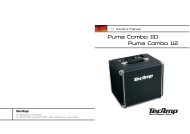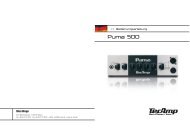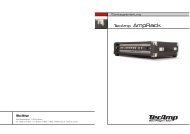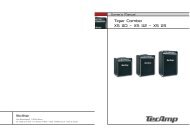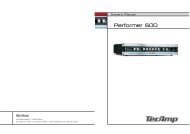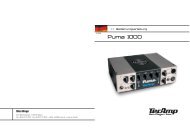Create successful ePaper yourself
Turn your PDF publications into a flip-book with our unique Google optimized e-Paper software.
Front Panel<br />
12 HI<br />
The “HI” control is centred at 5 kHz and offers a cut or<br />
boost of 15 dB. Turn it up for a biting, crystal clear rock<br />
or funk bass. Turn it counter clockwise to reduce hiss or<br />
generally dampen the sound for a muted reggae feel.<br />
13 HI BOOST<br />
Depress this switch and engage a boost of 12 dB at 10<br />
kHz. The LED above will illuminate. This is your switch if<br />
your strings are dead or if you are into a more HiFi-like<br />
bass sound with silky top end.<br />
14 LINE/EFFECT MIX<br />
Signals connected to the “LINE IN / EFFECTS LOOP<br />
RETURN” jack (#26a) can be added to the dry bass guitar<br />
signal according to your likings with this “LINE/EFFECTS<br />
MIX” control. The parallel “EFFECTS LOOP” (#26) is designed<br />
for the connection of one or more effects devices.<br />
The “RETURN/LINE IN” jack (#26a) can also be used to<br />
connect various external audio sources to the PUMA<br />
<strong>1000</strong> such as an MP3 player, a second bass guitar, or in<br />
order to just use the power amp of the PUMA <strong>1000</strong>.<br />
The “LINE / EFFECTS MIX” is a balance control adjusting<br />
the level of the effects sound as compared to the dry<br />
sound of the PUMA <strong>1000</strong> preamp. With the “EFFECTS<br />
MIX” control all the way to the left the signal of the<br />
external device, i.e. of the “RETURN” jack (#26a), is off.<br />
All you hear is the dry bass signal. Turning it up a little<br />
will add some effects to your sound. In this position (to<br />
the left of the knob’s centre position) the effects sound is<br />
processed in parallel with the unaffected or dry signal<br />
which enables you to preserve the integrity of the premium<br />
tone and feel the PUMA <strong>1000</strong> is capable of delivering.<br />
The more you turn the control clockwise, the more prominent<br />
will the “RETURN” signal become (i.e. the effect)<br />
while at the same time the dry signal will decrease.<br />
When the “MIX” control is turned all the way up to the<br />
“WET” position the EFFECTS loop effectively becomes a<br />
serial loop. Now the internal signal path is interrupted<br />
(rather than just tapped), sent out to the external device(s)<br />
where it gets processed (added with effects, modulated,<br />
modified, whatever) and returned to the amplifier<br />
as a whole.<br />
15 MASTER<br />
This is the overall volume control of the PUMA <strong>1000</strong> and<br />
works on the two internal power amp sections. It determines<br />
the level at the “SPEAKER OUTPUTS” (#27 - #29)<br />
as well as the “LINE OUT” jack (#25).<br />
Note: Each power amp features its individual “VOLUME”<br />
control on the back panel (#28a and #29a). Do make sure<br />
that they are turned up accordingly.<br />
16 MUTE<br />
The “MUTE” switch should be depressed when you<br />
power up or down your PUMA <strong>1000</strong> – the LED above the<br />
switch illuminates when the function is engaged. In this<br />
mode no audio signal will be processed and heard at any<br />
output except the “TUNER” jack (#24). That way you<br />
don’t have to turn down the volume for silent tuning or<br />
when changing instruments, thus you do without the<br />
nasty cling which you usually hear when you unplug the<br />
jack.<br />
The “MUTE” switch also interrupts the signal path at the<br />
balanced “DI OUT” (#18), no matter which position the<br />
switch “POST” (#17) is in (that way your silent tuning or<br />
changing instruments won’t be heard in the PA, either).<br />
During breaks the amp should be set to “MUTE” rather<br />
than switched off completely. That way the internal fan<br />
stays on and cools down the power amp circuitry if<br />
necessary. Disengage the “MUTE” function and start to<br />
rumble – now there is signal at all outputs again.<br />
17 POST<br />
With this switch the balanced “DI OUT” (#18) can be<br />
selected to be a “PRE” or “POST” preamp signal. In the<br />
“PRE” position (switch is not depressed) the “DI OUT”<br />
signal is tapped directly after the input stage including<br />
the “-10 dB” function (#2), if activated, as well as the<br />
“GAIN” control (#4).<br />
In the “POST” position (switch depressed) the “DI OUT”<br />
signal is taken after it has been processed by the complete<br />
preamp, i.e. including the “GAIN” control (#4), the<br />
tone control section (#8 through #13), and the “EFFECTS<br />
LOOP” (#14, #26). It is not affected by the “MASTER”<br />
control (#15). As a reference the LED above the “POST”<br />
switch illuminates when the “DI OUT” is set to “POST”.<br />
18 DI<br />
PUMA <strong>1000</strong> supplies a balanced line output signal for<br />
connecting to a house mixing board, recording console or<br />
external amplifier(s) with balanced inputs. Connect a<br />
shielded 3-core microphone cable with XLR plugs to this<br />
male XLR output.<br />
The need for an additional active DI box, which can be<br />
pretty expensive, is obsolete. Due to the advanced circuit<br />
design using only the best components available the<br />
high sound quality of the “DI OUT” makes it the amp of<br />
choice in any recording studio (you can use the PUMA<br />
<strong>1000</strong>’s pre amp on its own without driving any speakers).<br />
The DI signal can be tapped either before or after the<br />
preamp, as determined by the switch “POST” (#17).<br />
There is no need to be afraid of nasty ground loops as<br />
the DI output is soft-grounded.<br />
19 POWER<br />
At the risk of stating the obvious, this stylish yet heavyduty<br />
rocker switch is used to turn the PUMA <strong>1000</strong> on and<br />
off. Before you turn on the amp do make sure that the<br />
“MUTE” switch (#16) is depressed. Activating the<br />
POWER SWITCH (the top of the switch must be depressed<br />
towards the amp chassis) will make the TECAMP<br />
logo on the front panel (#21) illuminate. The amp is OFF<br />
when the bottom of the POWER SWITCH is depressed –<br />
the logo will no longer illuminate.<br />
20 FS/MUTE<br />
Connect the optional footswitch FSP1 to this 6.3 mm<br />
mono jack with cable which comes included with the<br />
switch. This will allow you to remotely switch the<br />
“MUTE” function (#16). When the function is engaged<br />
the eye of the puma on the footswitch will illuminate<br />
red.<br />
For the footswitch to work effectively do make sure that<br />
the “MUTE” switch on the front panel of the amp (#16)<br />
is not engaged.<br />
21 TecAmp Logo<br />
The TECAMP logo in the centre of the front panel will<br />
illuminate blue when the PUMA <strong>1000</strong> is switched on,<br />
provided the included power strip is plugged into the<br />
“POWER RECEPTACLE” on the back panel (#22) and the<br />
“POWER” switch (#19) is turned on.<br />
6 7



